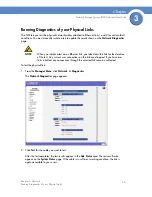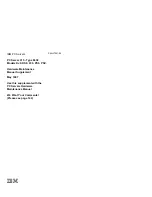
43
Chapter 4: Storage
Choosing a RAID Array Level
Network Storage System (NSS) Administrator Guide
Chapter
4
reconstruct the data lost when a drive fails in the array. When a failed disk is subsequently replaced,
the array must regenerate and rewrite the parity information of the array. This process is referred to
as “rebuilding”. During a rebuild, the array continues to be available for reads and writes. If the
parity information in the array gets out of synch with the data in the array, usually as the result of an
unexpected loss of power to the system, the array must be rebuilt. Like RAID1, if a disk is missing
from the array, the array is said to be operating in “degraded” mode.
•
Minimum Number of Disks:
3
•
Total capacity:
m x (n-1)
•
Advantages:
Increased reliability; The RAID array can sustain the loss of any single disk
without any data loss; Increased read and write performance.
•
Disadvantages:
Decreased aggregate storage capacity (you lose the equivalent capacity of a
single disk); CPU intensive calculation of parity, especially during rebuild operation; I/O
intensive during rebuild operation.
RAID10:
RAID10 is a combination of RAID1 and RAID0. The NSSimplements RAID10 as two, 2-disk
RAID1 mirrors, which are then used to build a RAID0 array. RAID10 can be thought of as “mirror,
then stripe”.
•
Minimum Number of Disks:
4
•
Total capacity:
2 x m
•
Advantages:
Increased read and write performance; increased reliability; the RAID array
can sustain the loss of any single disk without data loss; depending on which disks fail, the
array can lose up to two disks without data loss.
•
Disadvantages:
Decreased aggregate storage capacity (you lose half of the storage space)
JBOD:
JBOD lets you combine multiple disks of mixed capacities into a single logical storage device.
The capacity of the JBOD array is the sum of the total capacities of the individual component disks
(that is, it does not have the limitation of RAID0 where you lose some capacity when using mixed
sized disks). JBOD offers no performance increase compared to the component disks. It has lower
reliability than the component disks, as the failure of a single disk results, in general, in the failure of
the whole array. Depending on how you create volumes on the JBOD array, you may be able to
recover data when one or more disks in the JBOD fail. This, however, is not guaranteed.
•
Minimum Number of Disks:
1
•
Total capacity:
sum of capacities of component disks
•
Advantages:
Maximal storage capacity, especially when using mixed size disks
•
Disadvantages:
Decreased reliability
















































